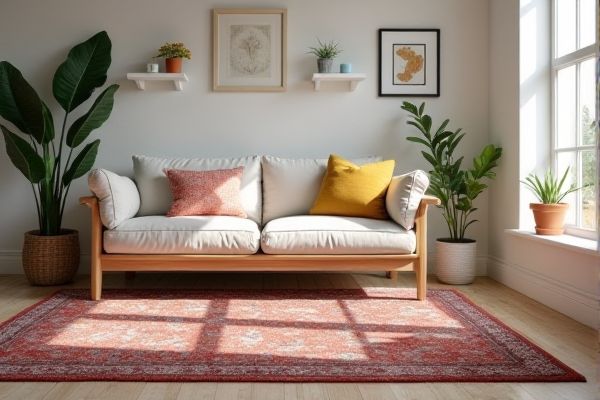
Area rugs provide versatile coverage for larger floor spaces, creating defined zones and adding warmth to living rooms or bedrooms, while runners are narrow and long, designed to fit hallways or stairs, offering protection and style in tight areas. Explore the rest of the article to understand which choice best suits Your space and design needs.
Table of Comparison
| Feature | Area Rug | Runner |
|---|---|---|
| Shape | Rectangular or various shapes | Long and narrow |
| Size | Varies; typically large enough to define a space | Typically 2-3 feet wide, 6-14 feet long |
| Primary Use | Defines living spaces, adds decor and warmth | Used in hallways, staircases, narrow spaces |
| Placement | Living rooms, bedrooms, dining rooms | Hallways, corridors, stairs |
| Function | Decorative, comfort, noise reduction | Protects floors, adds traction, decorative accent |
| Common Materials | Wool, synthetic fibers, cotton, silk | Wool, synthetic fibers, cotton, nylon |
| Cost Range | $50 to $1000+ | $30 to $500+ |
Area Rug vs Runner: Key Differences
Area rugs are typically larger and square or rectangular, designed to cover significant floor space in living rooms or bedrooms, while runners are long and narrow, ideal for hallways or staircases. The primary difference lies in their dimensions and placement, with area rugs providing a centerpiece for furniture arrangement and runners offering narrow coverage for high-traffic, elongated spaces. Material choices and patterns often vary to suit the functional and aesthetic demands of each rug type.
Choosing the Right Size: Area Rug or Runner?
Choosing the right size between an area rug and a runner depends on the space's dimensions and the intended use. Area rugs typically range from 5x8 to 9x12 feet, ideal for living rooms or dining areas, while runners usually measure 2 to 3 feet wide and 6 to 14 feet long, perfect for hallways or narrow spaces. Accurate measurement of floor space ensures the rug or runner fits seamlessly, enhancing both functionality and aesthetic appeal.
Best Uses for Area Rugs in Home Décor
Area rugs enhance living spaces by adding warmth and defining seating areas, making them ideal for living rooms, bedrooms, and dining rooms. Their larger size accommodates furniture placement, creating cohesive design zones and anchoring room layouts. You can use area rugs to introduce color, texture, and pattern, transforming the ambiance and comfort of your home.
Where to Place a Runner Rug
Runner rugs are ideal for narrow or high-traffic areas such as hallways, staircases, and entryways where they provide both aesthetic appeal and protection for flooring. Placing a runner rug along corridors enhances safety by offering traction and reduces wear from foot traffic, especially in homes with hardwood or tile floors. Their elongated shape fits perfectly in kitchens and alongside beds, adding warmth and comfort without overwhelming the space.
Design and Style Considerations
Area rugs offer versatile design options with larger sizes and diverse shapes that create focal points in living rooms or bedrooms, while runners are narrow and tailored for hallways or stairways, adding linear visual interest. You can select patterns, colors, and textures in area rugs to complement a room's overall decor, whereas runners often emphasize durability and flow, guiding movement through tight spaces without overwhelming the aesthetic. Choosing between an area rug and a runner depends on your spatial layout and how you want to balance functionality with style elements.
Durability and Maintenance Comparison
Area rugs generally offer higher durability due to their thicker and denser weave, making them suitable for high-traffic zones like living rooms. Runners, often placed in narrow hallways or staircases, require frequent cleaning because of their exposure to dirt and wear but are typically easier to maintain due to their smaller size. Both options benefit from regular vacuuming and periodic professional cleaning to extend their lifespan and preserve their appearance.
Cost Comparison: Area Rug vs Runner
Area rugs generally have a higher upfront cost than runners due to their larger size and more complex manufacturing processes. Runners, being narrow and long, use less material and require less labor, making them a more budget-friendly option for hallways or staircases. However, prices vary based on material, design, and brand, with high-end runners sometimes costing more than basic area rugs.
Safety and Comfort Benefits
Area rugs provide a larger surface that reduces slip hazards by covering more floor space, enhancing safety in rooms with hard flooring. Runners, typically placed in high-traffic narrow spaces, offer targeted cushioning that improves your comfort while walking and helps prevent falls, especially in hallways or staircases. Both options contribute to noise reduction and add warmth, creating a safer and cozier environment in your home.
Material Choices: Area Rug vs Runner
Area rugs and runners differ significantly in material choices, impacting durability and style. Area rugs often come in wool, cotton, and synthetic blends, offering plush comfort and varied textures for living spaces. Runners are typically made from durable materials like nylon or polypropylene, designed for high-traffic hallways and narrow spaces to withstand wear and tear.
How to Layer Area Rugs and Runners
Layering area rugs and runners enhances your space by adding texture, color, and dimension to your floors. Position a larger area rug as the base to anchor the room, then place a narrower runner on top in high-traffic zones or hallways to define pathways and create visual interest. Your layering strategy should consider rug materials, patterns, and sizes to harmonize the design while ensuring safety and comfort.
 homyna.com
homyna.com